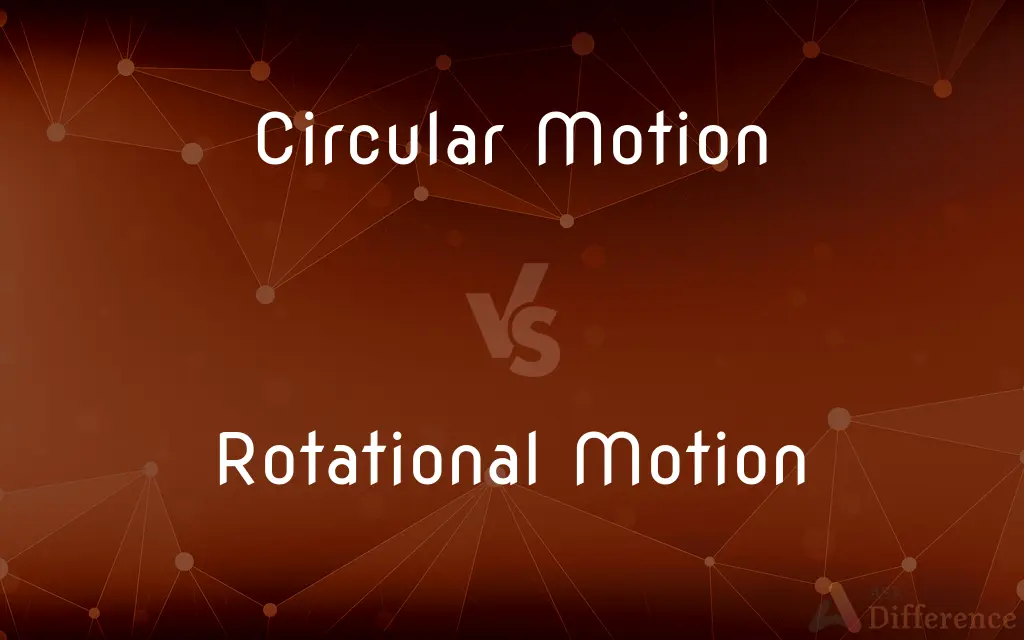Circular Motion vs. Rotational Motion — What's the Difference?
By Tayyaba Rehman — Published on January 16, 2024
Circular motion involves an object moving along a circular path, while rotational motion involves an object rotating around its own axis.

Difference Between Circular Motion and Rotational Motion
Table of Contents
ADVERTISEMENT
Key Differences
Circular motion and rotational motion are two fundamental concepts in physics, often used to describe different types of movements. Circular motion occurs when an object moves along a circular path, maintaining a constant distance from a fixed point, which is often referred to as the center of the circle. This type of motion is characterized by the object’s velocity always being tangent to the circle and its acceleration directed towards the center of the circle, known as centripetal acceleration.
Rotational motion, on the other hand, refers to the motion of an object rotating around its own axis. This could be a natural axis or an external one. In rotational motion, all points in the object move in circles around the axis of rotation. The speed of the points in the object depends on their distance from the axis; points closer to the axis move slower than those farther away. An example of rotational motion is the spinning of a wheel or the rotation of the Earth on its axis.
While circular motion can be considered a special type of rotational motion where the axis of rotation is external to the object, the two are distinct in their applications and implications. In circular motion, the entire object follows the same path, like a car moving along a circular track. In rotational motion, different parts of the object follow different paths, like points on a spinning disc moving at different speeds depending on their distance from the center.
In circular motion, the speed of the object is constant if the motion is uniform, but its direction constantly changes, making it an accelerated motion. In rotational motion, the angular velocity can be constant or change over time, depending on the forces applied. The study of these motions is crucial in understanding various physical phenomena and in designing mechanical systems.
Comparison Chart
Path of Movement
Movement along a circular path
Rotation around an axis
ADVERTISEMENT
Axis of Rotation
External to the object
Internal or external to the object
Speed of Points on Object
Uniform for all points
Varies with distance from the axis
Acceleration Direction
Towards the center (centripetal)
Depends on axis and rotation direction
Example
Earth orbiting the sun
Earth spinning on its axis
Compare with Definitions
Circular Motion
Path where distance to a fixed center remains constant.
A Ferris wheel exhibits circular motion as it turns.
Rotational Motion
Movement where points follow circular paths about an axis.
In rotational motion, every point of the object moves at a different speed.
Circular Motion
Constant speed but changing velocity due to direction.
The moon's circular motion around Earth keeps its face constant.
Rotational Motion
Rotation that can have varying angular velocity.
A figure skater controls her rotational motion by extending or retracting arms.
Circular Motion
Movement of an object along a circular path.
The satellite's circular motion around Earth is stable and predictable.
Rotational Motion
Includes both angular and linear components at different points.
In rotational motion, points further from the axis move faster.
Circular Motion
Motion with centripetal acceleration towards the center.
In circular motion, a car on a track experiences centripetal force.
Rotational Motion
Motion of an object spinning around its own axis.
A spinning top displays rotational motion.
Circular Motion
Uniform motion along the circumference of a circle.
Planets exhibit circular motion around the sun in their orbits.
Rotational Motion
Can involve both internal and external axes.
A planet exhibits rotational motion as it spins on its axis.
Common Curiosities
How is rotational motion characterized?
Rotational motion is characterized by an object spinning around an axis.
Can circular motion be considered rotational?
Circular motion can be a type of rotational motion with an external axis.
How does direction change in circular motion?
Although speed is constant, direction changes constantly.
Do all points move at the same speed in circular motion?
Yes, all points have the same speed in uniform circular motion.
Do objects in rotational motion have varying speeds?
Yes, speeds vary based on distance from the axis in rotational motion.
What defines circular motion?
Circular motion involves an object moving along a circular path.
What causes centripetal acceleration in circular motion?
Centripetal force towards the center causes this acceleration.
Is rotational motion always around an object's own axis?
Not always, it can be around an internal or external axis.
Can rotational motion be uniform?
Yes, if the angular velocity is constant.
What's an example of circular motion in astronomy?
Planets orbiting the sun exhibit circular motion.
Does rotational motion require external force?
It can, especially to start or change the rotation.
Can circular motion be seen in atomic structures?
Electrons moving around the nucleus exhibit a form of circular motion.
Why is understanding these motions important in physics?
They are fundamental for understanding dynamics in mechanical and astronomical systems.
What's an example of rotational motion in everyday life?
A ceiling fan's blades spinning exhibit rotational motion.
How does changing radius affect circular motion?
Changing radius can affect the centripetal force required.
Share Your Discovery

Previous Comparison
Sterling Silver vs. Stainless Steel
Next Comparison
SunPower vs. SunnovaAuthor Spotlight
Written by
Tayyaba RehmanTayyaba Rehman is a distinguished writer, currently serving as a primary contributor to askdifference.com. As a researcher in semantics and etymology, Tayyaba's passion for the complexity of languages and their distinctions has found a perfect home on the platform. Tayyaba delves into the intricacies of language, distinguishing between commonly confused words and phrases, thereby providing clarity for readers worldwide.













































